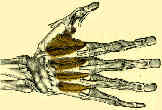- See: Intrinsic Muscles of the Hand;
- Origin: each from the 2 metacarpal bones between which it inserts;
- Insertion:
- superficial belly:
- inserts onto the lateral tubercle at the base of the proximal phalanx (proximal phalanges of 2nd, 3rd, and 4th digits)
to function as an abductor;
- deep belly: inserts onto the lateral tendon to help form the lateral band of the radial three fingers;
- Action: the 1st abducts the index finger, the 2nd radially flexes the
- middle finger, 3rd flexes middle finger & 4th abducts ring finger;
- all assists in flexing proximal phalanges of the index, middle and ring fingers at metacarpophalangeal joints;
- Nerve supply: palmar branch of the Ulnar nerve, C8 , T1
- Synergists: lumbrical, Palmar Interossei, Flexor Digitorum Profundus, Flexor Digitorum Superficialis
- First Dorsal Interosseous:
- largest of the interossei;
- origin: inner borders of first and second metacarpals;
- passes dorsal to adductor pollicis;
- insertion: extensor expansion mechanism on dorsum of finger;
- Summary:
- 1st, 2nd, and 4th, dorsal interossei - 2 muscle bellies:
- one of which inserts on the base ofthe proximal phalanx;
- one of which inserts on the dorsal aponeurosis;
- 3rd dorsal interosseous and all 3 volar interossei insert on to only dorsal aponeurosis;
Opponensplasty in intrinsic-muscle paralysis of the thumb in leprosy.
Movement patterns of interosseus-minus fingers.
Abductor pollicis longus transfer for replacement of first dorsal interosseous.


